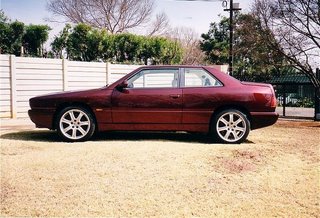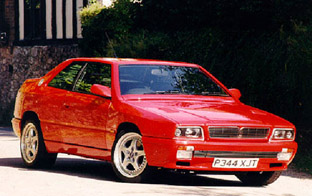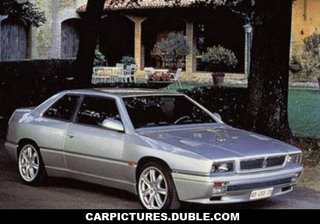




The Maserati Ghibli is a two-door, two-seater coupe released by Maserati in 1967. The V8-powered Ghibli was the most popular Maserati vehicle since the automaker withdrew from racing in the 1950s, and it outsold its two biggest rivals, the Ferrari Daytona and the Lamborghini Miura. It debuted at the 1966 Turin Motor Show.
The Ghibli's steel body, renowned for its low, shark-shaped nose, was designed by Giorgetto Giugiaro. Giugiaro, who today heads his own company ItalDesign, worked at coachbuilder Ghia when he designed the Ghibli.
The car was powered by a front-placed quad-cam 330hp V8 engine. It had a 0-60 mph acceleration time of 6.8 seconds, had a top speed of 154 mph and could be operated by either a five-speed manual or three-speed automatic transmission. Maserati fitted the car with two fuel tanks, which could be filled via flaps on either side of the roof pillars. The car also featured pop-up headlamps, leather sport seats and alloy wheels.
The convertible Ghibli Spyder went into production in 1969. The Spyders were relatively rare, and the coupes outnumbered them almost ten to one. The slightly more powerful Ghibli SS (335 hp) was released in 1970. The Ghibli went out of production in 1973 and found a successor the following year with the Bertone-designed Khamsin.
The Ghibli name was resurrected in 1992 with the release of the Maserati Ghibli II. It first appeared with 2.0 litre V6, operated via a six-speed manual transmission. The two-door, four-seater coupe was similar in appearance to Maserati Shamal, and did not sell as well as anticipated.
In 1994, the car was revised, and the engine was updated to a 2.8 liter V6. A refreshed interior, new wheels, a fully adjustable electronic suspension and ABS brakes were added. The high-performance Ghibli GT also entered production that year. The 1995 version reverted to spoked alloy wheels, as well as suspension and transmission modifications.
The coupe was built for luxury as well as performance. The car featured a Connolly leather interior with burl elm trim.
The Ghibli II has a top speed of 155 mph and a 0-60 mph acceleration time of 5.7 seconds.
The final year of production for the Ghibli II was 1997. It was replaced in the Maserati lineup by the 3200 GT the following year.
Several special edition models were produced by Maserati. The first was the Ghibli KS, followed by the race version Ghibli Open Cup which featured improved power through roller-bearing turbos, a freer-flowing exhaust, and remapped fuel computers. The Cup also featured a toned-down carbon fiber-trimmed interior with aluminum pedals and a MOMO steering wheel, and the drivetrain included tweaked suspension and Brembo brakes. To celebrate the world speed record on water, Maserati made a further 35 special edition Ghiblis called the Ghibli Primatist.
The Ghibli Cup had the highest ever per litre power output of any street legal car, surpassing the Bugatti EB110, Ferrari F40 and Jaguar XJ220.
The racing version Ghibli Open Cup is highly sought after by collectors today. In 1996, the car received a modification upgrade, resulting in similar track times to those of the Ferrari 355 Challenge. After the end of the 1995 racing season, several of the original 23 cars were used in national GT events.
The Ghibli's steel body, renowned for its low, shark-shaped nose, was designed by Giorgetto Giugiaro. Giugiaro, who today heads his own company ItalDesign, worked at coachbuilder Ghia when he designed the Ghibli.
The car was powered by a front-placed quad-cam 330hp V8 engine. It had a 0-60 mph acceleration time of 6.8 seconds, had a top speed of 154 mph and could be operated by either a five-speed manual or three-speed automatic transmission. Maserati fitted the car with two fuel tanks, which could be filled via flaps on either side of the roof pillars. The car also featured pop-up headlamps, leather sport seats and alloy wheels.
The convertible Ghibli Spyder went into production in 1969. The Spyders were relatively rare, and the coupes outnumbered them almost ten to one. The slightly more powerful Ghibli SS (335 hp) was released in 1970. The Ghibli went out of production in 1973 and found a successor the following year with the Bertone-designed Khamsin.
The Ghibli name was resurrected in 1992 with the release of the Maserati Ghibli II. It first appeared with 2.0 litre V6, operated via a six-speed manual transmission. The two-door, four-seater coupe was similar in appearance to Maserati Shamal, and did not sell as well as anticipated.
In 1994, the car was revised, and the engine was updated to a 2.8 liter V6. A refreshed interior, new wheels, a fully adjustable electronic suspension and ABS brakes were added. The high-performance Ghibli GT also entered production that year. The 1995 version reverted to spoked alloy wheels, as well as suspension and transmission modifications.
The coupe was built for luxury as well as performance. The car featured a Connolly leather interior with burl elm trim.
The Ghibli II has a top speed of 155 mph and a 0-60 mph acceleration time of 5.7 seconds.
The final year of production for the Ghibli II was 1997. It was replaced in the Maserati lineup by the 3200 GT the following year.
Several special edition models were produced by Maserati. The first was the Ghibli KS, followed by the race version Ghibli Open Cup which featured improved power through roller-bearing turbos, a freer-flowing exhaust, and remapped fuel computers. The Cup also featured a toned-down carbon fiber-trimmed interior with aluminum pedals and a MOMO steering wheel, and the drivetrain included tweaked suspension and Brembo brakes. To celebrate the world speed record on water, Maserati made a further 35 special edition Ghiblis called the Ghibli Primatist.
The Ghibli Cup had the highest ever per litre power output of any street legal car, surpassing the Bugatti EB110, Ferrari F40 and Jaguar XJ220.
The racing version Ghibli Open Cup is highly sought after by collectors today. In 1996, the car received a modification upgrade, resulting in similar track times to those of the Ferrari 355 Challenge. After the end of the 1995 racing season, several of the original 23 cars were used in national GT events.
No comments:
Post a Comment